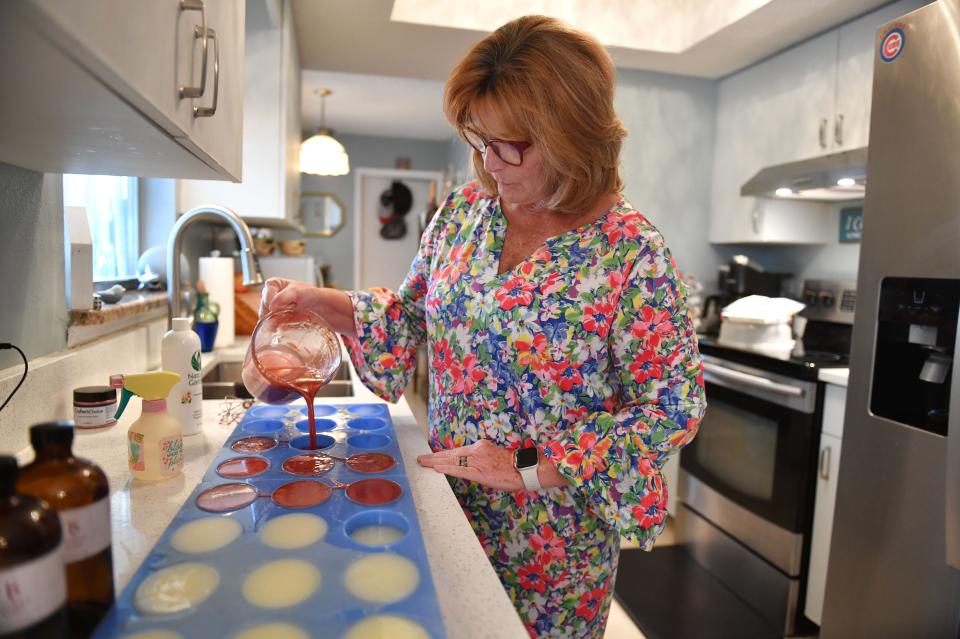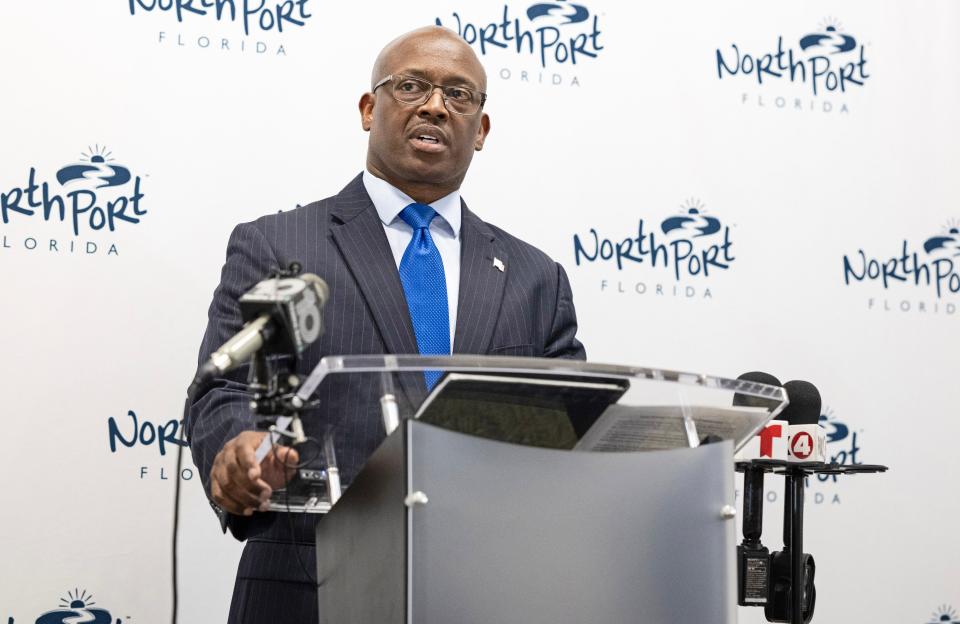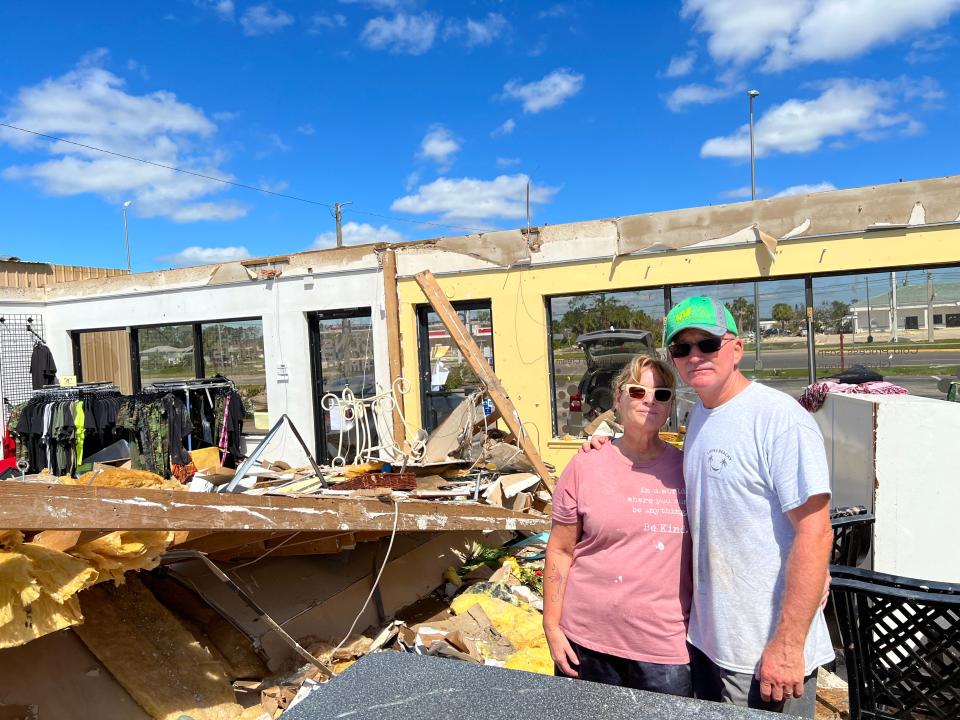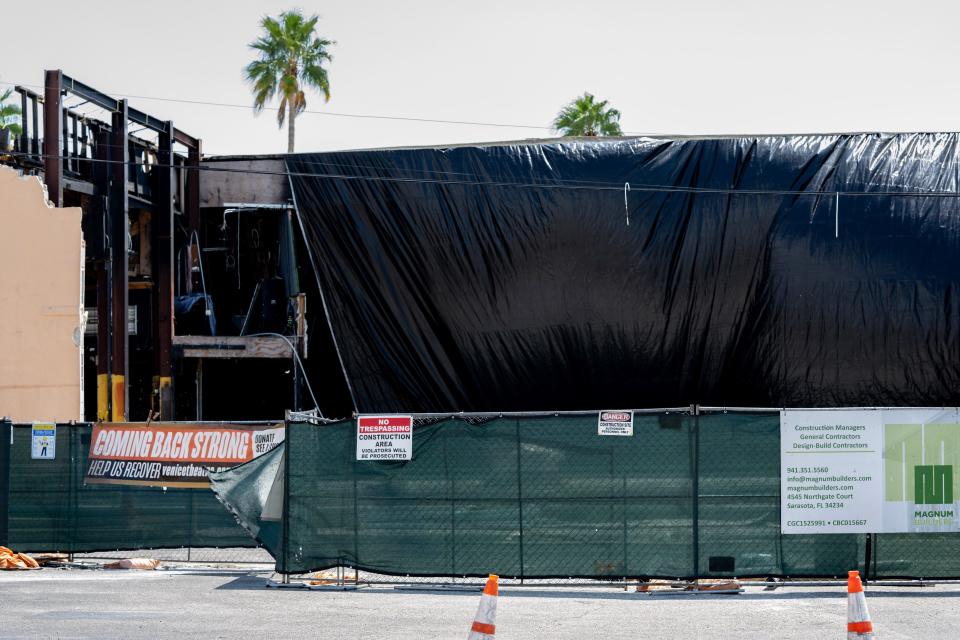A year after Hurricane Ian, Sarasota County working on long term recovery
One year after Hurricane Ian made landfall in Southwest Florida, Sarasota and Manatee counties are still recovering from the Category 4 storm's impact.
“Ian was something none of us had experienced in our lifetimes and probably never will again, " said North Port City Manager Jerome Fletcher. “The storm left scars on North Port but we continue to heal.”
Seven of the 149 deaths linked to Hurricane Ian occurred in the city, which suffered damage from the hurricane's initial passing after making landfall to the south in Lee County, and later flooding, as its prodigious rainfall along the Myakka River basin drained to the Gulf of Mexico.

Lee County – which wound up on the most damaging side of the storm – suffered cataclysmic damage, but Sarasota County Emergency Management Director Rich Collins noted that just 24 to 36 hours prior to landfall, forecasters had anticipated Ian would come ashore in Sarasota County.
At a recent news conference to discuss the storm's one-year anniversary, Collins said, “We were on the edge of a major, Category 4 hurricane.
“Ultimately that was the largest response in Sarasota County for a storm in as long as anyone can remember in the history of the County.”
Once the storm subsided and winds dropped below the 45 mph threshold to allow for police, firefighters and emergency services personnel to safely respond, there were more than 845 calls for aid waiting.
One of two state-provided Urban Search and Rescue teams were already on site by 11 a.m. Sept. 29. In all, search and rescue efforts in Sarasota County spanned nine days and ended Oct. 7.
That timeframe factors into a rule of thumb formula to determine how many days it will take for an area to recover, noted Chris Johnson, vice president of community impact for United Way of South Sarasota County, convener of the Long Term Recovery Group.
That formula, developed by National Voluntary Organizations Active in Disaster, attributes 100 days of recovery for each day of search and rescue – which means it could take 900 days for Sarasota County to recover from Hurricane Ian.
That recovery will be bolstered by $201.5 million in U.S. Housing and Urban Development block grant funding that will be disbursed through the Resilient SRQ program.
Later this year through early 2024, the Long Term Recovery Group will be working with World Renew Disaster Response Services and Convoy of Hope – two faith-based nonprofits – to repair homes of area residents in need.
Ian’s impact by the numbers
Some figures at the one-year anniversary of Hurricane Ian's arrival give some sense of the scope of the ongoing recovery:
In response to Hurricane Ian, FEMA has provided $1.1 billion to 386,600 homeowners and renters in Florida.
It has paid 82.2 million to 26,400 Sarasota County households, $17.9 million to 11,900 households in Manatee, $96.9 million to 27,100 households in Charlotte and $24.5 million to 4,600 DeSoto households.
FEMA has also provided temporary housing units, including apartments, travel trailers and manufactured housing units, to 1,361 households, with 107 in Sarasota County.
According to the Florida Office of Insurance Regulation, Hurricane Ian insured losses totaled $17.28 billion. with 86.1% of those claims closed as of June 28 – the most recent data available.
Statewide, 34,865 claims remain open without any type of payment. In Sarasota County, a total of 76,552 claims were filed, with 86.8% closed and 2,970 open claims remaining without payment. In Manatee, 13,962 claims were filed, with 88.9% closed and 688 open claims remaining without payment.
Lowball insurance offer snowballs
Recovery has been tough for North Port resident Jeffrey Rapkin. Hurricane Ian tore holes in the roof of the two-story home he shares with his wife an autistic daughter and left the interior exposed to the elements.
His insurance company, Heritage Property & Casualty Insurance Company, offered $9,000.
Rapkin is suing the company in circuit court. According to the case file, the cost to repair the home is in excess of $200,000.
He wanted to live in a larger FEMA mobile home on the property and in April filed suit against the city of North Port for its refusal to allow that placement.
A month later the City Commission changed its stance but by then, Rapkin said, his daughter had become settled in the FEMA-provided rental apartment on Toledo Blade Boulevard, so he didn’t want to move her again.
Rapkin and his wife Virginia still mow the lawn and he continues to pay the mortgage on a structure that he can’t repair.
“I lost my home,” said Rapkin, who noted that months without a roof have led to other issues with the interior walls and mold.
“It’s structurally unsound,” said Rapkin, adding that he expects the city to condemn it as unlivable. “Like everybody else, I can’t live it and I’m waiting for the court system to do something.
“We’re homeless with a house that might have been (saved) but for the holes in the roof.”
Still, Rapkin counts himself blessed because his family is safe and aren’t sick.
“We’re going to bound back, we’re going to bounce back,” he said. “I’m probably not going to ever own another house but we’ll get maybe an apartment that has more than two rooms – a bigger place – and we’re going to move on with our lives.”

Steady recovery at Holiday Park
Holiday Park and Recreation District, a 865-site, 55-and-older manufactured home community in North Port, was devastated on Sept. 28, 2022 as Ian's 100 mph wind gusts ripped through the area.
The rebuilding process after that has been slow but steady.
As many as 50 residents were living in trailers provided by FEMA, that’s been cut in half, as residents get new homes.
“Our park is in great shape now,” Holiday Park District Manager Carmela Coons said.
There are still empty lots and somewhere between 50 and 80 lots are for sale.
While the roads are owned by the district, the city of North Port has maintained the sewer system, Holiday Park board chair Cheryl Morris said, but they’re still working with the city to determine who is responsible for maintenance and upkeep of the stormwater drainage system and how to best upgrade that.
“After 50 years of sitting there, they need some work,” she added.
Repairs are ongoing. The Phase I clubhouse is done, and the swimming pool in Phase II is now running.
“The worst thing it affected was our finances,” Morris said. “We were woefully underinsured. We're still working with our insurance comapny to get all our money from Ian claims.”
The district has also filed with FEMA to reimburse about $200,000 spent on debris clearing but is still waiting on payment, though Morris said FEMA can’t pay until repairs are finished.
Morris lost a roof and a carport because of Hurricane Ian. “I was one of the very blessed that didn’t lose a lot,” she added.
Temporary sun shades and canopies are being put up so people can enjoy outdoor activities.
Common area repairs are proceeding slowly in part because the board only opted to raise the monthly assessment fees $5 to $140 a month.
“A lot of people here just put up a lot of money to fix their mobiles and we didn’t want to drown them in tax debt,” Morris said, then added they may consider another assessment in 2025. “We’re very careful watching our budget.”
Making progress in Englewood
Englewood Methodist Church, which has been busy with outreach efforts – including partnering with Action Crisis Teams, a faith-based nonprofit from Tennessee specializing in repair and recovery work – despite the church suffering “millions in damages” to its structure, noted church administrator Beth Harrison.
For almost eight months, the teams used the church as a place to sleep, while repairing roofs or performing major cleanups of Ian-damaged properties.
“It’s getting better slowly, but still a year later there’s still a lot of people who haven’t been paid on their insurance claims, still a lot of blue (roof) tarps.”
Deb Jeffes, a volunteer at the clinic hosted by Englewood Methodist noticed a drop in the census at the clinic since Hurricane Ian. “People cannot afford to live in this area; they're moving away from this area.”

“Right here in our subdivision, they've walked away,” added Jeffes, who lives with her husband Roy in Oyster Creek. "They've been her 15-18 years, they’re up in age, they're both 90 … they don’t have the energy and wherewithal to rebuild a house down here today.”
Elsewhere in Englewood, Teresa Karaffa, owner of the Lemon Bay Soap Company, has been making soap at home since Hurricane Ian destroyed the portion of Feodor’s Plaza on South McCall Road.
“They have not even begun to rebuild that part of the plaza,” said Karaffa, who figures she lost about $30,000 of product in the hurricane.
But her husband Dave saved the pot she uses to make soap, as well as an order of 25 blocks of glycerin she uses to make the soap.
“I’m still filling orders every now and then,” Karaffa. “Lemon Bay Soap Company has taken over our house but we manage.”
Costliest storm in Florida
Hurricane Ian is considered the third most costly in the U.S., behind Katrina in 2005 and Harvey in 2017, and costliest ever in Florida after causing nearly $113 billion in damage and 149 deaths.
It’s widely been called a 500-year storm, though Collins referred to it as a 1,000-year rain event.
“The storm parked for a number of hours over us and dumped an extensive amount of water across the state – unprecedented – from the center of the state on down, covered I-75 for a period of time, and had to stop traffic on I-75,” Collins said. “During the middle of the storm on Wednesday, anecdotally I received a call from the National Weather Service saying, 'Rich in the south part of your county – south Venice – we just recorded over 18 inches of rain in the last hour.'”
North Port, with 21.45 inches of rainfall in one location, had that beat.
Then the Myakka River at Myakka State Park reached a new record flood stage at 12.8 feet, shortly after midnight, Oct. 1. That combination led to severe flooding in the city of North Port, especially in North Port Estates.
The original part of the city was founded by General Development Corp. in 1959, after construction of nearly 80 miles of canals and waterways to create land that was carved into 80-foot by 120-foot lots on either side of the Myakkahatchee Creek.
The increased volume of water from Ian led to shattered roadways and bridges, notably along Price Boulevard, and flooded previously dry areas such as Country Club Ridge, north of the Cocoplum Waterway and east of McKibben Park, and eroded the north bank of the waterway at Water Control Structure 106.
The canal system designed in the 1950s was meant to handle a 10-year storm, or nine inches of rain over a five-day period.
“No system could have handled Hurricane Ian,” Fletcher said.
A city overwhelmed
In the days that followed, North Port first responders answered 1,312 emergency calls and “performed hundreds of water rescues,” Fletcher said.
The city enacted a curfew and agencies from around the country sent mutual aid.
The city collected more than 2.3 million cubic yards of debris in the first 120 days after Ian, compared to 50,000 cubic yards after Irma.
Fletcher noted that the city’s Social Services department has worked with agencies to distribute a total of $75,000 in hurricane relief vouchers to 300 city residents and worked with the United Way of South Sarasota County to help residents receive aid for rent, mortgage, utilities, medical cae, child care and some home essentials.
The city has spent about $85 million on recovery. Both the Utilities and Parks and Recreation administration buildings were destroyed by Hurricane Ian, with those administrators now working out of portables located at Dallas White Park.
Warm Mineral Springs was also closed for seven months, with all three historic buildings in limbo pending the negotiation of a public-private partnership agreement that would allow for their restoration, as well as the development of 60-acres of parkland that surrounds the springs.
Staff there are using portables for both administration and a restroom facility.
In total, the city has suffered about $7 million in damages to its facilities – including the Police Department, where all roof leaks have not been patched.
All repairs must follow strict FEMA procedures to guarantee reimbursement.
Fletcher noted that the city has recovered $27 million from FEMA, with another $15 million in reimbursement scheduled to come soon.
Fletcher said the storm has highlighted the city’s need to accelerate its replacement program for the aging water control structure system – now on a pace of about two a year – with the city applying to Sarasota County for a portion of the $201.5 million Resiliency SRQ block grants provided by the U.S. Dept. of Housing and Urban Development, in hopes of fast-tracking that process.
“This government, like many governments, kicked the can of infrastructure improvement down the road for far too long and now we’re having to repay that right now,” Fletcher said. “Whether it's our streets, whether it’s our buildings, we were not in a position to sustain the type of a storm – based on it being a 500-year storm, we may have not been able to sustain it anyway.
“Now it puts more emphasis on fixing our roads, fixing our buildings and making sure that we have structures that are capable of weathering another strong storm,” he added.
Last November, city voters approved an $80 million bond issue to widen and improve Price Boulevard. Fletcher noted that project is 60% designed and after Ian includes efforts to harden the major east-west roadway, including burying utility lines that had previously been tacked on the side of bridges over canals and waterways.
He’d like to convene a regional summit to talk about potential regional solutions for future hurricanes, including possibly building a reservoir north of the city, to capture future floodwaters that could also be used as an additional drinking water source.
A quick philanthropic response
At the same time federal, state and local governments geared up their response to Hurricane Ian, the local philanthropic community mobilized.
The Community Foundation of Sarasota County – working in partnership with The Patterson Foundation – established the Suncoast Disaster Recovery Fund of about $5 million, targeted to help support long-range programs for human service agencies in Charlotte, DeSoto, Manatee and Sarasota counties.
About half of those funds have been disbursed, noted Rebecca Abrahamson, a spokeswoman for the Community Foundation of Sarasota County, with payments lined up for the current grant cycle awaiting foundation board approval.
The Gulf Coast Community Foundation has committed about $3.5 million in grants, while the Charles & Margery Barancik Foundation has awarded about $2.5 million in grants related to Hurricane Ian.
All foundations are still accepting donations for the Hurricane Ian recovery effort.
Grants ranged from the Barancik Foundation awarding $95,000 to The Haven – a nonprofit that helps provide adults and children with intellectual or developmental disabilities with enhanced quality of life – to cover insurance deductibles to a variety of grants to help with mental health, childcare and programming or repairs ot facilities operated by the YMCA of Southwest Florida or the Boys & Girls Clubs of Sarasota & DeSoto Counties.
Gulf Coast provided $1 million over the next three years to help rebuild the Gene Matthews Boys & Girls Club in North Port, which was destroyed and several grants totaling $640,000 to the Venice Theatre, which is rebuilding the flyloft and entire main stage area of the Jervey Theatre.
Destruction of the theater flyloft was one of the earliest images of Hurricane Ian damage in Sarasota County to circulate internationally.

Venice Theatre restoration supervisor Murray Chase noted that a British troupe who had performed in Venice saw storm images in London.
“What they saw from Venice was, of course, the theatre and having performed in that theatre, they were devastated by it,” Chase said.
About $3 million has already been spent to bring the theater to its current state – which included 266 roof patches and complete electrical rewiring – with another $13 to $14 million ultimately required to finish and outfit the facility.
The hope is to have the theatre finished by December 2024, with an ambitious goal of reopening in January 2025.
535 days to full recovery
That National Voluntary Organizations Active in Disaster rule of thumb suggests that as of Sept. 28, the hardest hit parts of Sarasota County still have 535 days – more than a year-and-a-half – until full recovery.
The Long Term Recovery Group, run under the auspices of the United Way of South Sarasota County and includes more than 25 nonprofits and agencies.
While out-of-area nonprofits like World Renew and Convoy of Hope will play a big part in that recovery, local foundations and familiar faces from the local nonprofit community will play a big part as well.
When it comes to things like FEMA they're going to cycle in and out,” Johnson said. “Long term recovery is just that – it takes a while and we’re still going to be here until the last house gets fixed. So we make sure that everyone is made whole again.
“All of our local partners are still going to involved – the Catholic Charities, the Salvation Army's all of these folks are still going to be here on the ground, no matter what FEMA may do or the other government agencies do we’re still going to be operating when it’s done,” he added.
The group’s intent is to help affected families return to normal as soon as possible.
Case managers, affiliated with nonprofits such as The Salvation Army, St. Vincent de Paul Society, Catholic Charities, the United Methodist Committee on Relief and the United Way of South Sarasota County work with people who have signed up for help.
More than 57,000 people applied for FEMA assistance in Sarasota County, and more than 11,700 have verified losses.
World Renew partnered with the Long Term Recovery Group and assessed more than 280 families in May. In Sarasota County, those assessments identified almost $3.75 million in funding needs. More than $3.1 million of that was identified as construction materials cost, to go along with almost $410,000 in furniture and $215,000 in appliances.
“Some of the grant applications I’ve seen are about all the people who are back in their homes but have no working appliances because of flooding,” said Abrahamson, who added that she knows someone who has no appliances and received no insurance payment after a tree went through his roof. “He’s still barbecuing his breakfast.”
“You don’t think about it if you’re not affected by it on a daily basis but for a lot of people life is still significantly different.”
More Ian numbers
FEMA’s National Flood Insurance Program has paid $4.3 billion to 45,700 policyholders throughout Florida, including $55.4 million to 1,200 Sarasota County policyholders, $51.2 million to 2,000 in Charlotte and in $10.3 million to 140 policyholders in DeSoto. Figures for Manatee County flood insurance policy payouts were not available.
Statewide, FEMA paid for the hotel stays of 4,560 families as they made repairs to their home or looked for permanent housing. In Sarasota, County that involved 123 households, compared with 76 in Manatee, 242 in Charlotte and 49 in DeSoto.
The U. S. Small Business Administration (SBA) has approved $1.5 billion for homeowners and renters and $405 million to businesses.
FEMA has also spent $1.2 billion in FEMA public assistance for state, local governments and certain non-profits in response to Hurricane Ian. In Sarasota County that has amounted to $49.6 million and in Manatee $2.7 million.
This article originally appeared on Sarasota Herald-Tribune: A year after Hurricane Ian, Sarasota County still works on recovery

